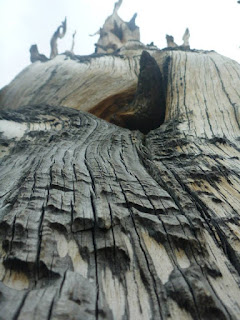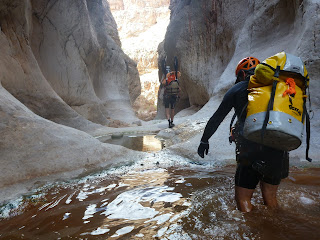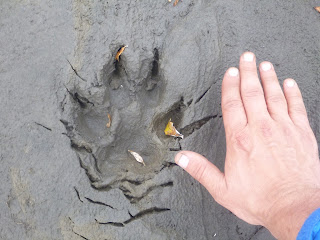Here’s another older trip I’m writing up, mostly because I have a video to go with it. In the summer of 2013, I wanted to do a trip up to the mountains. I had a big trip planned to Colorado, but it wouldn’t take place until September, and I was going a little stir-crazy in Arizona. So I decided to take a five-day trip to see some mountains. I considered a variety of options in New Mexico and California, before settling on Great Basin National Park in Nevada, mostly because it was another national park to add to the resume, and because I had done zero hiking in Nevada.
On Day 0, I drove up and stayed at the El Cortez hotel near downtown Las Vegas, mostly because it was only $29/night on a Tuesday night. I met up with an old friend who had moved up to Las Vegas a few years back and we did the normal vegas routine, drinking it up in some strip casinos and gambling on blackjack.
Despite the boozey night, the next morning I was up bright and early for the drive up to the park. Along the way, I diverted over to visit Valley of Fire State Park. This is a first-rate park with some excellent red rock formations, narrows, slickrock, and petroglyphs. I did the drive through the park and attempted some brief hikes, but at 100+ degrees I didn’t make it far. Still it was great to take in the scenery – will definitely need to return in cooler weather to do some more exploring.
The drive up to Great Basin was uneventful, and sooo empty. Driving around the back roads of Arizona and Utah is action packed by comparison, in Nevada there is nothing out there. The road unspooled through massive tracks of desert basin between big mountain ranges, usually arrow straight and fast to drive. After 5 hours on the road I was happy to finally pull into the tiny hamlet of Baker, Nevada, a gateway to the park itself. In the past few years of exploring, I had grown used to the carnival atmosphere of other gateway towns like Moab, Jackson Hole, or Springdale. Baker was still a sleepy little small town in the middle of nowhere, with none of the touristy crap that floods similar towns close to national parks.
I’d find the town’s sensibility reflected in the park as well. Because Great Basin is so far from major cities – its five hours to either Las Vegas or SLC – the park remains a forgotten outpost on the edge of civilization. It has not become overwhelmed with the regulations and bureaucracy that have overtaken parks like Zion or Grand Canyon. There’s no line of cars at a gate to pay exorbitant entrance fees– you pay a few dollars on the honor system by pulling into the visitor center. It’s possible to roll into the park and snag a primo campsite on a summer weekend without planning six months ahead. You need not worry about permits for anything other than cave tours – just pull into the trailhead, fill out a form to leave on your dashboard, and off you go. This is what I imagine visiting the national parks was like back in the 70s and 80s, and it was refreshing to know the experience was still available in some places for those who seek it out.
After
snagging a permit to tour Lehman Caves on the last day of the trip, I
drove up the park road. The road winds its way up the ridges of the
Snake Range to around 9800 feet at the base of Wheeler Peak. The views
get progressively better as you get higher and higher.
At the end of the road, I reached Wheeler Peak campground and set up camp. As mentioned before, this camp cannot be reserved, but it rarely fills to capacity. And it’s a wonder too, with beautiful green meadows and aspen groves in the shadow of alpine views.
The next morning, I set off with a daypack. There’s a whole network of trails radiating out from the campground, and my intention was to knock them all off in a single day.
The first and primary goal was the summit of Wheeler Peak. Wheeler Peak is the high point of the park and the Snake Range, in addition to being the second highest peak in Nevada. I couldn’t rightly visit Great Basin National Park without bagging the summit.
The high up was nicely graded, but a struggle all the same as I gained nearly 3000 feet in elevation. Shortly after cresting above treeline I passed a group of deer hanging out at altitude. Silhouetted against the sky, they made for great pictures.
Near the top of the peak, clouds started to roll in. This was greatly concerning as I was about to be the highest thing around. I left my metal hiking poles next to the trail and continued up quickly.
The summit sits at 13,065 feet, and the view is vast and far-ranging. You’re immediately surrounded by the alpine summits of the Snake Range, but beyond that are vast seas of desert. Having driven through the area just the day before, I knew just how vast and stunningly empty all that territory was.
I didn’t linger on the summit due to the clouds. I made my way back to my trekking poles and continued on down, back below treeline to the basin at the base of Wheeler Peak.
I wasn’t done yet, however. Rather than simply follow the trail back to the campground, I took a right onto the Alpine Lakes Loop trail. This trail winds through the trees to visit Stella and Teresa Lakes. Like most alpine lake, the scenery was stunning with the hulking mass of Wheeler Peak towering behind the lakes.
The forest along the trail was wonderful as well. There’s a certain type of open and airy pine forest that can be found in some western mountain ranges. I think it’s associated with dry air and somewhat sandy soil. I first encountered this in the Sierra Nevada during my PCT hike, and (given the context) it has a primal association with wild, beautiful mountain ranges for me. The previous few years, I had done long hikes in the Wind Rivers and the Canadian Rockies. While absolutely stunning, these hikes were both in the northern Rockies, which features a much different type of forest just below treeline. Here, in Great Basin, I delighted to find that open and airy forest of my big adventure again.
The forest climaxed in a trip up through the Wheeler Peak Bristlecone Pine Grove. At up to 10000 years old, they’re among the oldest living things on the planet. Living right at treeline, the trees in this grove had all kinds of personality, with knarled and twisted trunks to adapt to the windy cold conditions.
I pushed a bit beyond the grove to reach the base of the Wheeler Peak Glacier. This is the only glacier in Nevada. The brewing thunderstorm finally started as I pulled up the glacier, which seemed appropriate for such a remote and harsh area. I lingered long enough to take a few photos before turning back.
After a second night at the Wheeler Peak campground, I headed back down the scenic drive for breakfast in Baker. Today I’d transition from daytrip to a proper adventure. I headed over to the trailhead for the Baker Lake trail. This trail was a pleasant ramble through the woods, six miles up to treeline at Baker Lake.
While the trail itself was pleasant and easy woods hiking, the scenery got appropriately dramatic at Baker Lake, which nestled in a bowl below scenic alpine cliffs. I set up camp just 100 feet back from the lake shore, and spent the afternoon reading and watching storms roll over the lake surface.
The morning sun lit up the lake environs.
I packed up quickly and headed off-trail up over the divide separating the Baker Lake drainage from Johnson Lake.
Pulling down out of the high country for the last time, I picked up the Johnson Lake trail along the shores of the lake. This trail led through aspen and conifer groves, passing cabins and mining remnants from days gone by.
I missed a junction somewhere along the way, and ended up down on the valley floor, which meant having to backtrack and re-climb about 1000 feet to get up over the Johnson Creek Divide.
Below the divide, the trail rambled through great meadows to reach the Baker Lake trailhead once again.
Before leaving the park, I wanted to visit Lehman Caves. Lehman Caves was the original tourist attraction here – it was the reason the area became known and the reason it was protected, with the Snake Range serving as a nice bonus. So the final thing I did at Great Basin National Park was to pull into the visitor center for the Grand Palace cave tour.
Lehman Cave is a beautiful marble cave.
It’s been well protected and has all of the stalagtites, stalagmites, helictites , popcorn and other features that people visit these places for.
In particular, Lehman Caves is known for having a concentration of rare shield formations.
I’ve not spent much time visiting caves. I think I saw a few in Ohio during trips to my grandparent’s home when I was a kid, but I’d never visited any as an adult, post PCT-hike when the outdoor obsession bit me big time. So Lehman Caves was a revelation, a fresh encounter with a type of wild place that had remained unknown to me up to that point. I’m hesitant to dive into caving as a DIY adventurer – it takes serious know-how, and a tolerance for claustrophobia – but I’d make it a point to visit some other famous “show caves” in the coming years as a result of this trip.
I camped that night outside the park, cutting an hour or so off the drive the next day. In the morning, I hit the road early and arrived at Cathedral Gorge State Park in the early morning hours.
Cathedral Gorge was a great pit stop on the way home. The entire gorge is filled with siltstone narrows and formations.
I drove into the park and hiked up into the formations. It was a different and unique sort of narrows experience than I’d had before.
After Cathedral Gorge, it was time to put the nose to the grindstone and head home again. A great trip to put under the belt, in an area most people will never visit despite its national park status.














































































